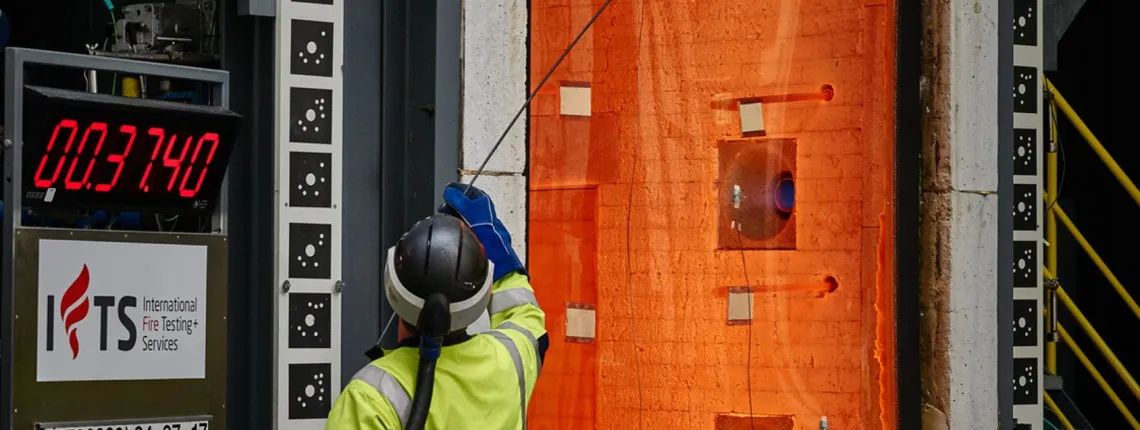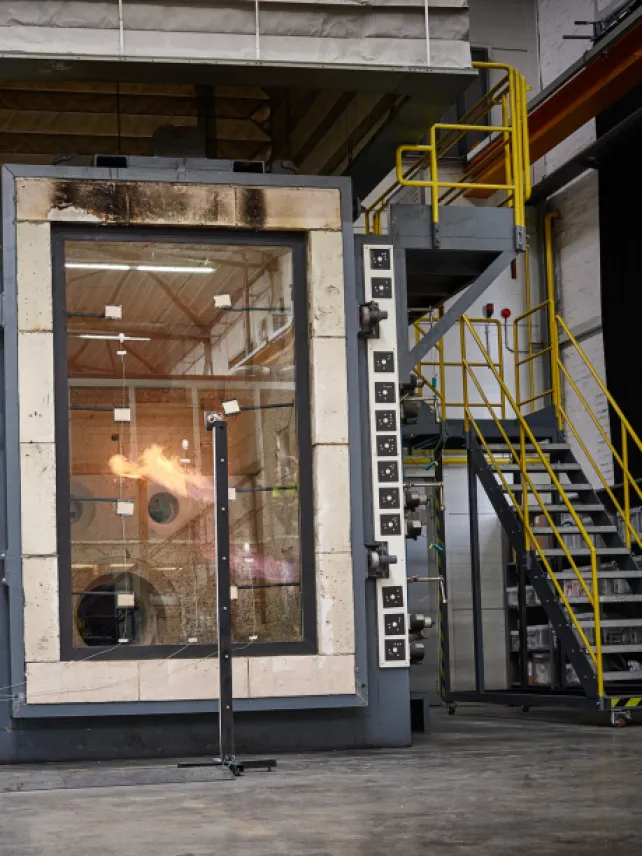Importance of Compliance in Fire Testing

Fire safety is a critical concern in modern construction, particularly regarding materials that must endure extreme temperatures, such as fire rated glazing solutions. These elements play a crucial role in fire containment, providing both structural integrity and the necessary time for evacuation. To ensure their effectiveness, fire testing is essential for verifying how well materials perform under fire conditions.
Fire resistance testing standards, such as those defined in EN, UL, ISO and IS, establish rigorous guidelines for assessing a material’s ability to withstand fire. The accuracy of these evaluations depends on two key factors: the application of instrumentation and adherence to the time-temperature curve.
This article explores the importance of compliance in fire-rated testing, the key standards involved, and how industry leaders like Vetrotech uphold the highest levels of fire protection and safety.
Understanding Fire Testing
Fire testing is a systematic evaluation process that assesses how materials, components, or assemblies behave under fire conditions. Conducted using standardised methodologies, these tests measure various attributes such as:
-
Stability (R): The material’s ability to withstand fire without breaking down.
-
Integrity (E): How well a system prevents flames and hot gases from passing through.
-
Insulation (I): The material’s capacity to limit heat transfer.
-
Radiation Control (W): The ability to reduce the spread of heat radiation.
Fire testing ensures that materials perform as expected in real-world fire safety scenarios, ultimately reducing risks and enhancing safety.

What is the Purpose of Fire Testing?
The primary purpose of fire-rated testing is to validate the safety and effectiveness of fire-resistant products. Key benefits include:
1. Safety Assurance
Fire testing confirms that materials can withstand fire exposure without failing, preventing the spread of flames and smoke. For example, fire-rated systems to specific standards (like EI or EW) help compartmentalize a fire to the origin area for the prescribed duration.
This vital delay provides a crucial time for occupants to evacuate and for fire and rescue services to intervene. Ensuring a building's structural elements remain intact during a fire is fundamental to its overall safety.
2.Regulatory Compliance
Meeting both national and international building fire code requirements is a non-negotiable aspect of construction projects. International standards such as BS 476 (UK), EN 1364 (EU), UL 263 (USA), and national standards such as IS 16945 & 47 (India), GB 9978 (China), TCVN 9383 (Vietnam), CNS 11227 (Taiwan), AS 1530.4 (Australia & NZ), and the UAE Fire and Life Safety Code outline comprehensive fire prevention requirements that must be adhered to.
These regulations are designed to ensure a minimum level of fire safety and protection, serving as benchmarks for national building code compliance and legal adherence. Non-compliance not only jeopardises safety but can result in costly fines and delays.
3. Performance Validation
Fire rating (e.g., E, EW, EI) is determined through rigorous testing to validate a product’s performance under standard fire conditions. This performance validation ensures products maintain their structural stability, insulation, and containment capabilities.
Validating these properties ensures products can withstand high heat exposure up to 1100°C for 120 minutes, limiting the potential for structural collapse, smoke infiltration, and heat transfer.
4. Product Development
Fire testing plays an instrumental role in developing fire rated glass and fire rated doors technologies. By testing in accordance with global fire resistance standards, manufacturers can identify areas for improvement, driving innovation in fire resistant glazing and enhancing fire and safety standards across industries.
5. Risk Reduction
Fire safety compliance mitigates the risk of loss of life and property damage. Properly tested and certified fire rated glazing solutions help compartmentalize and prevent the rapid spread of fire, reducing fatalities and structural damage during an emergency.
Comprehensive fire-rated solutions also integrate with sprinklers, smoke alarms, and smoke containment barriers to improve overall building safety.
6. Third-Party Certification
Fire resistant elements such as fire rated doors and glazing solutions are crucial for life safety. Hence, third-party certification from recognised bodies such as UL, Intertek, or TÜV ensures that products meet international fire safety code requirements and maintain consistent quality.
Certified solutions strengthen market credibility, boost customer confidence, and align with regional regulations such as the Dubai Building Code, Abu Dhabi Building Code, and UAE Fire Code.

Different Types of Fire Testing Standards
Fire testing follows various standards worldwide, each catering to specific regional or industry requirements. Understanding these standards ensures fire safety compliance across different sectors:
-
ISO 834 (Global): Specifies the standard time-temperature curve for fire resistance testing.
-
IS 16945 & 47 (India): Provides fire resistance criteria tailored for Indian construction standards.
-
EN 1364/13501 (Europe): Defines fire resistance classifications for fire rated glazing and partition walls.
-
BS 476 (UK): Establishes fire resistance requirements for building materials and structures.
-
GB/T 9978 (China): Outlines fire testing methodologies for structural elements.
-
CNS 11227 (Taiwan): Sets fire safety performance requirements for various building materials.
-
TCVN 9311 (Vietnam): Establishes national standards for fire resistance testing.
-
AS 1530 (Australia): Covers fire resistance and reaction to fire for construction materials.
-
UL 263/9/10C (USA): Focuses on fire resistance for building components and glazed fire doors.
-
IMO FTP (Marine): Regulates fire safety in marine vessels and offshore structures.
Fire Safety Compliance: An Overview
Fire safety compliance refers to the strict adherence to fire protection and fire code regulations to safeguard buildings, occupants, and property.
For glazed fire doors and partitions, compliance ensures that fire-rated materials can withstand flames, heat, and smoke for a defined duration, preventing rapid fire spread. This strengthens industry credibility and drives innovation in fire rated glass doors and materials.
Importance of Compliance in Fire Testing
Compliance in fire testing of glazed elements is essential for ensuring safety and protecting property. Adhering to fire resistance standards ensures these materials withstand fire conditions, preventing the rapid spread of flames and smoke. This compliance is critical for public safety, maintaining industry credibility, and fostering innovation in construction.
Fire resistance tests, based on established standards, evaluate how materials perform under fire conditions, crucial for ensuring buildings meet fire and safety requirements and contribute to overall resilience.
1. Protection of Life and Property
Rigorous fire safety compliance helps protect lives and minimise property damage during a fire. Certified fire-resistant materials slow or prevent fire spread, providing crucial time for evacuation and enabling fire and rescue services to intervene promptly, ultimately reducing loss of life and property damage.
2. Legal Obligations and Regulatory Requirements
Fire safety regulations are legally mandated in many regions. Compliance with both national and international building fire safety standards ensures projects meet the safety requirements of authorities such as Abu Dhabi Civil Defense Fire Code, reducing the risk of penalties or delays
3. Enhanced Market Credibility and Customer Confidence
Complying with fire safety code requirements enhances a company’s reputation by demonstrating commitment to fire protection and quality. Certification from third-party organisations like TÜV or Intertek builds trust among regulators, developers, and stakeholders.
Vetrotech’s Assurance
At Vetrotech, we are fully committed to ensuring the highest standards of fire resistance compliance and providing peace of mind to our clients.
1. Rigorous Testing and Adherence to Standards
Vetrotech conducts thousands of fire tests annually following international standards including IS, ISO, BS, EN, TCVN, and others ensuring all fire testing procedures meet regulatory requirements under the UAE Fire and Life Safety Code.
2. Comprehensive Testing in Accredited Labs
Our testing methodology evaluates materials, structures, and solutions under realistic fire conditions at accredited laboratories worldwide, ensuring reliability, consistency, and accuracy in performance.
Ensuring Lifelong Fire Safety Compliance
Compliance in fire testing is essential for protecting lives, properties, and businesses. Reliable, rigorously tested fire rated glazing and fire rated doors not only ensure fire safety compliance but also prevent legal and financial risks.
With stringent adherence to global and national building codes, Vetrotech remains committed to providing fire-rated solutions that uphold the highest levels of fire safety and reliability.

